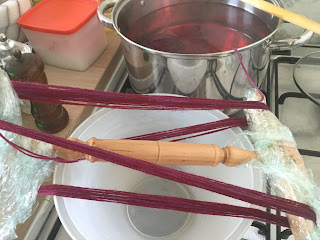But first of all... decisions... decisions... do I chop up the pits, or leave them intact. I had read both opinions (some going so far as to say you shouldn't even use damaged pits)... well, I went with chopping them up. Might be an interesting future experiment to do a direct comparison of both methods...
Anyway, I soaked the chopped up pits in water for a couple of hours, then fired up the dye pot. Sure enough, the water turned a really nice orange red. I let the dye cool down before straining it, putting the chopped pits into a net, then adding my pre-mordanted (12% alum; 5% cream of soda) yarn (100g) - a wool / silk / ramie blend - and the net containing the pit chips to the dye bath.
I used a thermometer and made sure to switch off the gas whenever the dye bath reached around 80 °C (so far, I am dyeing on our gas stove, and even on the lowest possible setting everything boils up like crazy after a while). When the temperature dropped below 70 °C I switched on the stove again. I held the temperature in this range for about an hour, then let yarn cothe cool down with the dye bath. I did not rinse immediately - hung the yarn outside to dry for a while first. Then rinsed, and hung it to dry completely.
The dye bath looked pretty much depleted after this, so I was going to pour it out the next morning… But guess what, when I came back in the morning, it looked darker again, so I decided to boil it up again… and yes, there seemed to be enough dye again to give it another try. So I put a 100 g skein of 100 % wool (mordanted the same way as the first skein) in after the dye bath had cooled down again a little. Heated it up a couple of times during the day, then let it cool down in the bath… and got another, slightly lighter, peach colour.
Here’s a picture of both skeins together for better comparison.
Have to start saving avocado pits again, and the peel, too. I read that they keep well in the freezer.
Possible future experiments:
- Try to extract the dye from the pits over the course of several days… see if I can get more saturated colours.
- Compare peel dye and pit dye.
- Compare whole pit dye and chopped up pit dye.
- Effects of dye bath pH on resulting colour.











